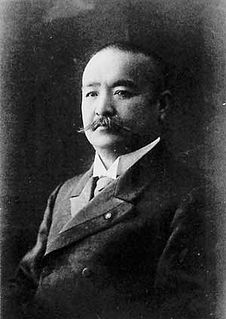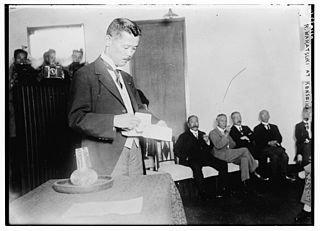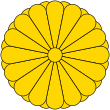
Viscount Takahashi Korekiyo was a Japanese politician who served as a member of the House of Peers, as the 20th Prime Minister of Japan from 13 November 1921 to 12 June 1922, and as the head of the Bank of Japan and Ministry of Finance.

Inukai Tsuyoshi was a Japanese politician, cabinet minister, and Prime Minister of Japan from 13 December 1931 to 15 May 1932.

The Taishō period, or Taishō era, is a period in the history of Japan dating from 30 July 1912, to 25 December 1926, coinciding with the reign of the Emperor Taishō. The new emperor was a sickly man, which prompted the shift in political power from the old oligarchic group of elder statesmen to the Imperial Diet of Japan and the democratic parties. Thus, the era is considered the time of the liberal movement known as the "Taishō democracy" in Japan; it is usually distinguished from the preceding chaotic Meiji period and the following militaristic-driven first part of the Shōwa period.
This article gives an overview of liberalism in Japan. It is limited to liberal parties with substantial support, proved by having had representation in parliament. The sign ⇒ means a reference to another party in that scheme. For inclusion in this scheme it isn't necessary that parties labelled themselves `liberal`.
Political parties appeared in Japan after the Meiji Restoration, and gradually increased in importance after the promulgation of the Meiji Constitution and the creation of the Diet of Japan. During the Taishō period, parliamentary democracy based on party politics temporarily succeeded in Japan, but in the 1930s the political parties were eclipsed by the military, and were dissolved in the 1940s during World War II
General elections were held in Japan on 20 February 1932. They were the last elections before the May 15 Incident, which marked the temporary end of party politics in Japan. Rikken Seiyūkai won 301 of the 466 seats in the House of Representatives.

The Rikken-Dōshi Kai was a political party active in the Empire of Japan in the early years of the 20th century. It was also known as simply the Dōshikai.

The Kenseikai was a short-lived political party in the pre-war Empire of Japan.

The Rikken Kokumintō was a minor political party in the Empire of Japan. It was also known as simply the Kokumintō.

The Taishō political crisis was a period of political upheaval in Japan that occurred after the death of the Meiji Emperor in 1912. During the twelve-month period following the emperor's death, the Japanese government was led by three different prime ministers as the government attempted to restore the balance between the influence of Japan's elder statesmen and that of the Japanese public, as embodied in the Meiji Constitution.
The Daidō Club was a political party in Japan.
The Kensei Hontō was a political party in Japan.
The Yūkōkai was a political party in Japan. It was active from 1906 until 1908.
The Seiyūhontō was a political party in Japan. It was active from 1924 until 1927.
The Kakushin Club was a political party in Japan.
The Shōwakai was a political party in Japan.
The Boshin Club was a political party in Japan.
The Liberal Party was a political party in Japan.
The Chūsei Club was a pro-business political party in Japan.










